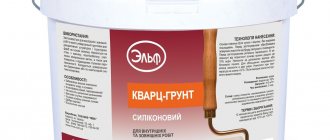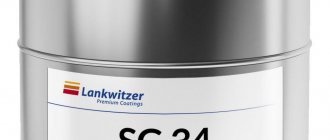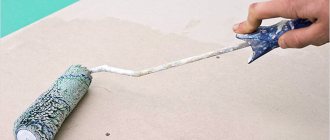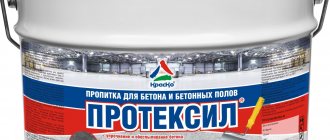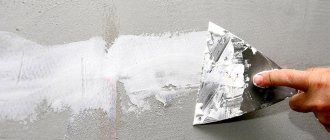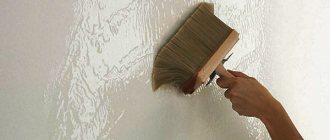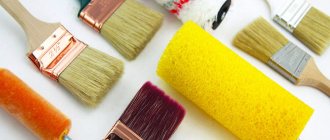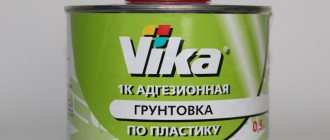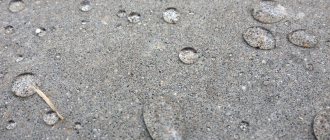Primers or impregnations are a special liquid substance with which the surface is treated in order to prepare it for painting, putty and other finishing work. As a standard, it includes substances capable of forming a film (various adhesives, bitumen and oils, resins), as well as pigments, drying boosters and other inclusions. More recently, wallpaper glue was used to prime surfaces (when it was necessary to prime the base for wallpaper), or PVA/silicate glue, which was diluted with water, or simply primed with paint heavily diluted with a solvent. The wood was usually treated with drying oil. Nowadays, these methods are already a thing of the past, and on the market it is possible to purchase both budget versions of universal primers and high-quality highly specialized substances from world-famous brands.
Today's construction industry is able to offer a wide range of primer compositions:
- Substances of deep penetration;
- Primers that combat moisture permeability;
- Improving/strengthening adhesion of paints;
- Anti-corrosion and insulating;
- Antiseptic and fungicidal, etc.
The scientific definition of a primer states that it is “a composition that is applied as the first layer to a surface prepared for painting/finishing, in order to create reliable adhesion of the covering (top) layers of the coating with the working surface and designed to level its absorbent properties.” Conventionally, all primers can be divided into impregnations, i.e. solutions used for initial surface treatment, and adhesion-improving compounds. Both formulations in finished form and on a dry base, which require mixing with various solvents, can be sold.
Purpose of primer mixtures
First of all, priming the bases will help to apply subsequent layers of paintwork in a better manner. In addition, such a coating will last much longer. There are some types of primers that can regulate the porosity of the surface being treated while simultaneously strengthening it. There are also compounds that prevent premature wear of materials and protect them from rust. It is worth noting that the use of primers for painting will significantly reduce the consumption of expensive paintwork materials. Thanks to priming, the paint lays down in an even layer, and existing unevenness will be smoothed out.
Knauf
No less popular on the Russian market today are the products of the Knauf .
This international manufacturing company was founded in 1932 in Germany, and in 1949 their first plant producing gypsum building mixtures appeared in Bavaria. The company's products have been present on the domestic market for more than 25 years, and during this time it has managed to open more than 10 factories throughout the country. And this does not take into account those enterprises located in other countries. Today the company offers solutions for construction work of various levels of complexity, servicing large orders and facilities. Naturally, in addition to this, it produces plasterboard sheets, insulating materials, and of course dry building mixtures. Popular among a large number of users is their quick-drying primer, as well as a composition with the addition of quartz sand.
Official website: knauf.ru
Specific characteristics of primers
Each mixture has its own special properties that help when processing various surfaces:
- Compositions for deep penetration - they are necessary for working on porous, loose or other surfaces that can absorb liquid like a sponge. The use of such compositions will significantly strengthen the working base and reduce the consumption of the final material, for example paintwork materials, which without a primer will be absorbed into the base in exorbitant quantities. The same compositions are perfect for surfaces intended for wallpapering.
- Antibacterial compounds are usually used in bathrooms and bathrooms, because they have water-repellent characteristics and can prevent the growth of fungus in damp areas. The adhesion in such substances is so high that the material, for example, tile adhesive, is firmly fixed to the base. From this it can be seen that the risk of crack formation is reduced significantly, which means the likelihood of the growth of harmful microorganisms will also decrease. To achieve greater effect, such compositions are recommended to be applied in several layers.
- Anti-corrosion compounds - prevent the oxidation of metals, which means successfully resisting the formation of rust.
- The compositions are non-contact (they are also adhesive) - they include the smallest grains of quartz sand, therefore, after treatment, the surface becomes rough, and it is possible to apply putty or glue wallpaper on it without effort. These compositions are used in the case when the initial surface is so smooth and incapable of absorbing liquids (i.e. does not have the required degree of porosity) that the applied material simply cannot “grasp” it.
Bolars
One of the youngest and yet popular companies producing construction mixtures is the Bolars .
This is another domestic manufacturer that has gained fame both at home and far beyond its borders. The history of the company began in 1999, which, you see, is really not much. Nevertheless, it was then that the production of building mixtures and finishing materials was founded. Over time, the company did not stop developing, simultaneously equipping production with modern and high-tech equipment, equipping the plant with automated lines. It also has certified scientific laboratories at its disposal. At the moment, the company is among the top three leaders in the Russian market for the production of professional building mixtures. Their composition is intended to strengthen the structure of cellular concrete, gypsum plasters and cement-sand/lime screeds.
Official website: bolars.ru
Existing types of primer mixtures
Modern and most popular types of primer mixtures are represented by the following compositions:
- Acrylic or emulsion - they are suitable for almost any type of substrate: wood and plasterboard, concrete and brick, as well as for applying putty and primer. The only exception can be metal bases, since the vast majority of these substances do not contain anti-corrosion substances. Among the main advantages of acrylic-based compositions are ease of use and the ability to be diluted with tap water. They dry quickly (2-4 hours) and have no unpleasant odor, which makes acrylic primer extremely convenient for treating residential premises. Acrylic primers can be produced for both deep penetration and surface application.
- Alkyd - widely used to prepare wood surfaces for painting, and their drying time varies from 10 to 16 hours. This priming solution, as it were, “loosens” the surface layer of the wood, which significantly increases the adhesion between the wood and the paint. This primer qualitatively increases the durability of the coating and extends its service life. It is possible to prime metal substrates with alkyd mixtures, however, they are ineffective when treating mineral surfaces.
- Polyurethane and epoxy are essentially paints that are diluted with appropriate solvents. As a rule, they process concrete in order to prepare it for applying enamel.
- Shellac - such compounds are highly specialized and are used for processing branches on cut coniferous trees. They can also be used with water-soluble stains.
- Polystyrene - used on plastered and wood substrates, however, due to their high toxicity, they should be used only for outdoor work or in well-ventilated non-residential structures.
- Special compounds for metal - they are divided into phosphate, insulating and protective. Insulating materials contain red lead and zinc white in their structure. They simply do not interact with the metal, and mechanically do not allow moisture to penetrate it. The group of insulating compounds includes phenol-formaldehyde and glypthal compounds. All of them have different drying times - from a couple of hours to several days. Protective (also known as passivating) ones have a high price, but at the same time they have a high quality threshold. Can be used for both ferrous and non-ferrous metals. Due to the high zinc content (about 90%), this coating can withstand aggressive environments well. Phosphate ones increase the adhesion of metal to paint, while simultaneously producing an anti-corrosion effect. Before starting work, this primer must be diluted with an acidic solvent. Application should occur in several layers under stable enamel. Most suitable for working on ferrous metals.
Henkel (Ceresit)
And the first in this ranking is the German company Henkel , which is engaged in the chemical industry, producing a wide range of products, which, in addition to building mixtures, also includes various cleaning and detergents, cosmetics, adhesives and sealants. In this case, we are considering the brand Ceresit .
Over the long period of existence of the manufacturing company, as well as the brand itself, the accumulated years of experience allow them to provide excellent modern solutions for repair and construction work. As for their primers, the main component of the composition is synthetic resins, and their base is water-dispersed. The positive features of this combination are high absorbency and reliable protection against premature drying.
Official website: ceresit.ru
Features of primer for mineral surfaces
Mineral bases are considered to be:
- Plaster;
- Aerated concrete;
- Concrete;
- Cinder block;
- Brick.
That is, almost all the materials from which the walls and ceilings of buildings are built.
Soil with deep penetration rightfully occupies the main position in preparing “bare walls” for coating. The essence of this operation is to impregnate the base material as deeply as possible, while the polymer component adheres well to the surface particles, making it more porous. This significantly increases the adhesion of the subsequent layer to the mineral base. Often, deep penetration soils have antifungal (fungicidal) inclusions.
In the case when it is necessary to prime a base that is too porous, weak and loose, then it is necessary to use a reinforced primer. A similar composition has more adhesive components in its structure, i.e. when interacting with the material, they will significantly strengthen its upper part. It is worth noting that the consumption of the primer mixture will depend on the porosity of the base being treated. Strengthening primers are typically used on plaster that does not contain enough cement, such as in worn-out buildings. However, you should always remember that such mixtures can only strengthen the material to the depth of their penetration. From here it is clear that they will not save old and crumbling plaster.
A general purpose primer (also known as universal) should be applied between coats. It is designed to improve grip. Allows you to apply paintwork in an even layer. When using it, it is necessary to take into account the structure of not only the base material, but also the paint that will be applied as a subsequent layer.
An anti-alkali mixture will be required only if solvent-soluble paints containing alkali are subsequently used. The preferred surfaces in this situation would be newly laid concrete, cement screed or a surface treated with anti-friction.
The non-contact mixture is used for working on particularly smooth surfaces, for example, marble slabs, drywall, or bases painted with oil paints. The main purpose of its use is to increase the adhesive properties of the base.
Scope of application
Deep penetration primers fill the porous structure of concrete, making it more resistant to external influences and increasing adhesion to finishing materials.
Concrete has a very high density, hence very low absorbency. Therefore, plastering or painting such a surface without prior preparation will not be effective.
Such compositions will be the only right choice if you plan to use heavy wallpaper as interior decoration - not a single glue can hold the sheets on a concrete wall.
Despite their intended purpose, concrete primers can be used on:
- plastered walls;
- drywall;
- brick;
- gas blocks;
- foam concrete blocks.
Due to their properties, the compositions of this group are rightfully considered universal.
Primers with high penetrating ability are ideal for preparing substrates in areas with high levels of humidity - in bathrooms and kitchens. Here the walls are constantly in contact with moisture, which can cause the appearance of fungus and wall mold.
A primer containing antiseptic substances is guaranteed to prevent the development of pathogenic microflora.
Features of wood priming
The process in question must occur in several steps. First, it is necessary to protect the tree from biological factors that can cause destruction of the base. This includes traces of the activity of rodents and insects, as well as manifestations of rot, the formation of fungus or the germination of algae. For such protection, special impregnations should be used, which have the following properties:
- Insecticidal;
- Pesticide;
- Fungicidal;
- Antiseptic.
This impregnation should be applied in several layers.
Other primer mixtures should be applied to the wood immediately before painting (and in special cases, replace it). They are designed to smooth or swell the base, depending on future processing purposes. After using them, the paintwork material will lay down clearly more evenly, and its consumption will significantly decrease due to less absorption.
Special mixtures for priming wood can be represented by means for removing oiliness from the surface of products made from coniferous trees. Such agents are divided into saponifying and dissolving agents. However, upon completion of processing, mechanical finalization of the work (sanding) will be required.
Before priming
In order for the wood, first coated with a primer and then varnish, to look impressive and last a long time, it must be properly prepared and stocked with the necessary tools.
Tools you will need:
Having stocked up on tools, you can begin the preparatory work. All wooden surfaces are treated with sandpaper, smoothly moving it along the wood fibers. It is necessary to gradually change the grain size from coarse to finer. To process large areas (such as parquet, panels), it is more convenient to wrap a bar of the required size with abrasive paper; for smaller parts (furniture elements), it is more convenient to wrap a rubber plate.
Tip: It is most convenient to collect fine dust and wood shavings with a vacuum cleaner. After thoroughly processing and cleaning the surface, you can begin to apply the primer layer.
Features of metal priming
When priming metal (especially black varieties) that has obvious traces of rust, first of all you need to use a corrosion converter. After using it, mechanical grinding should be carried out, and only then proceed to priming the base. These steps must be performed even if the primer mixture itself already contains the main element of the converter - phosphoric acid. The range of samples of mixtures for priming metals, both ferrous and non-ferrous, is very wide, therefore, you should always check the manufacturers' recommendations. For example, galvanized iron should be primed only with solutions for non-ferrous metals.
General information
The first thing that interests home craftsmen when they are faced with a similar task is whether it is possible to paint with paint over varnish? Of course, it is best to remove the old coating, but if this is not possible, or you need to save time, then you can paint over the old coating.
True, in order to say with confidence whether it is possible to apply paint to varnish, it is necessary to clarify what kind of paint and varnish material we are talking about. The fact is that not all compositions are suitable for these purposes. For example, you cannot use nitro paint, as the old coating will begin to peel off over time.
In addition, before applying the coloring composition, the surface still needs to be prepared in a certain way.
Features of primers with non-contact mixtures
In practice, non-contact primer has proven itself to be far from being the optimal option for preparing surfaces before laying ceramic tiles, much less porcelain stoneware. This is due to the fact that tile adhesive has a higher adhesive ability than the soil itself. The adhesion strength of tile adhesive starts from 0.5 MegaPascals, while for a non-contact composition it is only 0.4 MegaPascals (with crumbling, weakly absorbent materials). All this leads to a decrease in the direct adhesion of the glue to the surface. Due to the large mass of porcelain stoneware or ceramic tiles, increased pressure will be created on the primed base. As a result, the non-contact may “peel off” from the surface along with the tiles or begin to peel off.
In order to avoid a negative result, in the process of preparing the base it is necessary to use high-quality primers from well-known brands. It is also not recommended to use non-contact solutions on various types of loose surfaces. On such substrates, the primer will not be able to provide the adhesion declared by the manufacturer. The adhesion force of the mineral base to the applied layer will be significantly reduced. Taking into account the fact that the adhesion of plaster solutions starts from 0.3 MegaPascals, one cannot expect a positive effect from such treatment.
In addition, you should not apply non-contact solutions to non-absorbent substrates, which include plastic, metal or wooden surfaces (some types of wood). With such bases, the layer will not be able to adhere normally, and even if this happens, we must not forget about the main property of non-contact - its vapor permeability. The accumulation of condensation between the primer and the surface will very quickly lead to the appearance of defects.
Conclusion
Now we have a general idea of how and why we need to prepare lumber for subsequent painting. As a result, you can purchase one or another primer and prepare your wooden cottage or summer house for painting work.
More useful information can be found by watching the video in this article.
Applying varnish to wooden surfaces will increase the service life of furniture, parquet and other products. This preserves the texture of the wood and prevents discoloration and fading of the paint.
Preliminary stage: Preparing the wooden surface by tinting.
To give the wood the desired color and improve the texture, before applying varnish . Next, the surface is sanded with a grain of at least P100 (in accordance with the FEPA standard).
Basic application rules
Working with primer substances is quite simple; anyone can cope with this task, without special skills and experience, however, some rules must still be followed:
- Before starting work, you will need to clean the base being treated from construction debris, oily stains and dust;
- If there are metal parts on the surface, they must be cleaned of traces of corrosion;
- The primer is applied with a wide brush or a paint roller, and the level of uniformity of the layer being placed must be maintained;
- For large premises, it makes sense to use a spray gun, which will significantly reduce the time spent on work;
- The vast majority of primer solutions are very sensitive to temperature conditions, so work must be carried out in the temperature range from +5 to +30 degrees Celsius;
- If the base being treated is highly porous, then priming occurs in at least two or three layers, simultaneously sealing the resulting cracks and cracks;
- Each subsequent primer layer is applied only after the previous one has completely dried.
IMPORTANT! Some types of primers require additional preparation, so they should be diluted with a solvent or water to obtain the required consistency. As a rule, a one-to-one proportion is used unless the manufacturer specifies a different ratio.
LNPP
The last on our list of popular primer manufacturers on the Russian market is the Samara company LNPP , which was founded in 1992.
Initially, for the first five years of its existence, the company specialized in the supply and installation of energy-saving facade insulation systems from American manufacturers. Today their direction has not changed much. They are still focused on working with facades, but since 1998 production has been launched, which now allows the company to provide not only acrylic facade insulation systems, but also building materials for various purposes. By the way, the company’s product range is quite decent, although it is narrowly focused on facades. However, their primer can be used almost everywhere, and not just for exterior work, as it is excellent for treating walls before painting with acrylic or water-based paints.
Official website: laes-samara.ru
The article was written for the site.
Tags:Preparing for room renovation
Questions of wise choice
In order for priming work to be carried out properly, the following issues must be examined:
- Decide on the material of the surface being treated - whether it contains any different constituent structural elements (for example, structures made of metal and wood that need to be painted over at the same time).
- Check the condition of the base - if the surface is too porous or loose, it will absorb a significant amount of primer, which means increased consumption of funds. Accordingly, a choice will need to be made in favor of certain compounds.
- It is necessary to consider the type of layer on which the primer solution will be applied.
- Assess the environmental conditions - is the humidity level expected to increase, or is a sharp increase/decrease in temperature expected.
- Assess the approximate consumption of primer material - this indicator will affect the method of application. For example, painting walls or other surfaces with a brush is a labor-intensive process, however, in this case the savings will be obvious. If you work with a roller, the consumption will increase. Professionals choose the “golden mean” and use a spray bottle.
When choosing a mixture, the name of the manufacturer is also important, because brands that value their reputation supply the best product to the market, guaranteed to provide a high-quality effect. These include:
- "ARRR";
- "Marshall";
- "Tikkurila";
- "Polymin";
- "Escaro";
- "Knauf".
Prospectors
Starateli can seriously compete with many European brands in the field of dry construction mixtures on the Russian market .
Of course, in comparison with the first ones, this brand can be considered relatively young, since it appeared in 1992. However, enough time has passed for them, which has allowed them to grow into a manufacturer offering quality products, which, as you might guess, brought them popularity. According to the company itself, it learned from the mistakes of more experienced and “mature” manufacturers, gradually improving its recipes and technologies. The company uses exclusively selected raw materials and components from the leaders of the European market in its products, complementing all this with high-quality modified components and continuous quality control at all stages of the production process. Therefore, the primer from this manufacturer is quite universal.
Official website: starateli.ru
Rating of the best primers for 2022
Acrylic
3rd place: “SENBION S-Gr-14810/1”
This mixture contains a special filler of original production, which specifically increases the adhesive degree of application. Therefore, the composition can be used on various materials without doubting the quality of adhesion. The manufacturer recommends working with a primer on thin-layer materials, as well as on OSB boards and plywood bases. The coating is breathable, durable, and has good absorbent properties. Prevents the appearance of mold and mildew.
| Name | Index |
| Manufacturer country | Russia |
| Sales volume, liters | 1.03 |
| Additional properties | No |
| Price, rubles | 170 |
SENBION S-Gr-14810/1
Advantages:
- Low price;
- Antiseptic properties available;
- Without smell.
Flaws:
- Afraid of frost.
2nd place: “DALI 1L 6 15701”
The material is distinguished by its strengthening properties and is excellent at preparing loose and porous mineral surfaces for processing. These include wood, plaster, concrete and brick. It is possible to work with the mixture both outside and indoors. Thanks to its dispersion-water base, the composition will save on finishing painting.
| Name | Index |
| Manufacturer country | Russia |
| Sales volume, liters | 1 |
| Additional properties | Has frost resistance |
| Price, rubles | 190 |
DALI 1L 6 15701
Advantages:
- Frost resistance available;
- Budget cost;
- Fast drying.
Flaws:
- Not detected.
1st place: “RUST-OLEUM Zinsser bulls yey 1-2-3 255403”
A fairly expensive type of primer from a popular Western brand. Despite the more than high price, it is a product with increased efficiency. The composition applies very smoothly, has a high level of adhesion to the surface, and has a stain removal function. It can easily work on aluminum and galvanized metal, as well as glossy paintwork materials and ceramic tiles. The resulting coating will be resistant to the formation of fungus and mold. It has a pH-neutral component, so it can be used in food production.
| Name | Index |
| Manufacturer country | Sweden |
| Sales volume, liters | 0.95 |
| Additional properties | Possesses pH neutrality |
| Price, rubles | 1600 |
UST-OLEUM Zinsser bulls yey 1-2-3 255403
Advantages:
- Versatility;
- Multifunctionality;
- PH neutrality.
Flaws:
- Non-critical weak odor of ammonia (dissipates quickly).
Contactless
3rd place: “GU - 5l Goodhim 73091”
This composition is particularly versatile, comes in bulk containers, and is perfectly suited for processing both horizontal and vertical surfaces. It is quite suitable for preparing the base for the final stage of finishing. It is possible to work both indoors and outside on the facade. The manufacturer claims extremely low consumption - from 80 to 120 grams per square meter.
| Name | Index |
| Manufacturer country | Russia |
| Sales volume, liters | 5 |
| Additional properties | Contains inclusions of fire retardants |
| Price, rubles | 560 |
GU - 5l Goodhim 73091
Advantages:
- Spacious packaging at a low price;
- Economical consumption;
- Contains inclusions of fire retardants.
Flaws:
- Not detected.
2nd place: “TERRACO TERRAGROUNT Maxi universal”
This product is a budget version of its Western counterpart, has a low cost, however, has not lost much in its functionality. Supplied in very large containers. Has fungicidal properties. Can be used on concrete and brick, and has the characteristics of increased penetration.
| Name | Index |
| Manufacturer country | Russia |
| Sales volume, liters | 10 |
| Additional properties | No |
| Price, rubles | 780 |
TERRACO TERRAGROUND Maxi universal
Advantages:
- Increased volume of commercial containers;
- Increased degree of penetration;
- Antiseptic properties.
Flaws:
- Not found.
1st place: “CERESIT CT 19 5 kg 1/120 23681”
This composition is intended for treating fragile, crumbling and poorly absorbent surfaces (cement, concrete, brick, stone). You can work both inside buildings and on the facade. The manufacturer claims increased adhesive properties and guarantees a high degree of smoothing. Suitable for finalizing decorative finishes, although it also works well for applying glue.
| Name | Index |
| Manufacturer country | China |
| Sales volume, liters | 5 |
| Additional properties | No |
| Price, rubles | 850 |
CERESIT CT 19 5 kg 1/120 23681
Advantages:
- Good price-quality ratio;
- Ability to level the surface;
- Dries quickly.
Flaws:
- Not detected.
Polyurethane
2nd place: “TIKKURILA INDUSTRIAL TEMADUR 50 TAL polyurethane 2.25 l 50672210330”
An excellent water-based polyurethane paint that has the properties of a primer, which means there is no need for a final finishing step. Supplied in fairly large containers. The composition also has the ability to be tinted. Product of a world famous Scandinavian brand.
| Name | Index |
| Manufacturer country | Finland |
| Sales volume, liters | 3.5 |
| Additional properties | Tinting |
| Price, rubles | 2800 |
TIKKURILA INDUSTRIAL TEMADUR 50 TAL polyurethane 2.25 l 50672210330
Advantages:
- Possibility of tinting;
- There is no need for final finishing;
- Product from a well-known Finnish company.
Flaws:
- Not suitable for medical institutions.
1st place: “Polyurethane two-component repair composition for floors for 15 sq.m. GRASPOLIMER 280010"
This mixture is primarily proposed to be used as a repair agent. It is designed to repair horizontal surfaces in industrial premises. The mixture is resistant to temperature changes, exposure to direct sunlight, mechanical shock and increased vibration. The manufacturer claims that one of the main characteristics is economical consumption.
| Name | Index |
| Manufacturer country | Russia |
| Sales volume, liters | 5 |
| Additional properties | No |
| Price, rubles | 4500 |
Polyurethane two-component repair composition for floors for 15 sq.m. GRASPOLIMER 280010
Advantages:
- Dries quickly;
- Resistance to mechanical damage;
- Economical spending.
Flaws:
- Not detected.


